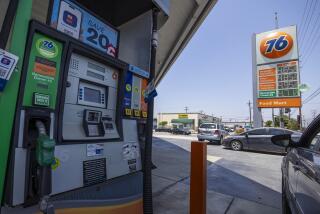Long Beach: Governorâs Model for Oil Drilling
With its five camouflaged islands pumping oil 24 hours a day, Long Beach serves as Gov. George Deukmejianâs model of how coastal California can coexist with offshore drilling.
During 16 years as a state legislator from Long Beach, Deukmejian concluded that his district could host offshore oil drilling without suffering any harm.
His former district has helped shape the governorâs view that other parts of the coast should share in the responsibility of providing Californiaâs petroleum.
âHave you ever been to Long Beach?â Deukmejian asked a reporter in Monterey who questioned last week whether offshore drilling was consistent with the governorâs goal of increasing tourism.
Wells and Tourism
âYou know, weâve had oil drilling off the coast of the city of Long Beach for 25, 30 years, and we also have a lot of tourism in that area,â Deukmejian said. âYou donât necessarily have to exclude having a healthy economy in exchange for having a good environment. We can have both.â
In recent weeks, Deukmejianâs views have brought sharp criticism from environmentalists and placed him at odds with nearly every member of Congress from coastal California--Republican and Democrat alike.
The governor has been singled out by critics for his role last month in persuading the House Appropriations Committee to lift a four-year moratorium on oil exploration off California.
A longtime opponent of the moratorium, Deukmejian sent a last-minute telegram to the committee that some say spelled the difference in the panelâs 27-26 vote to kill it.
Three Miles Off Coast
Ending the moratorium could allow the federal government to permit oil exploration three miles or more from the coast (Long Beachâs man-made oil islands are much closer to shore).
As Deukmejian traveled around the state last week making a series of campaign-style appearances, he was dogged by questions on the offshore oil issue. In Monterey, he was picketed by environmentalists and local officials at a fund-raising dinner.
Calling the governor the âDuke of Oil,â opponents of offshore oil exploration said they will seek to make the subject an issue in Deukmejianâs campaign for reelection next year.
Some of Deukmejianâs fellow Republicans suggested privately that the governor is out of step with the stateâs voters on the oil question.
âHeâs misreading the people of California, who care very much about where they live,â one GOP congressional aide said in Washington. âI would say that the majority of Californians believe that offshore drilling is one of the last places to go for energy independence.â
The official, who asked to remain anonymous, noted, however, that the governor may come out ahead politically by reaping large campaign contributions from the oil industry, money he could spend on television commercials to overcome negative reaction to his oil policy.
The petroleum industry has been generous to Deukmejian. From 1981 to 1984, the governor received $399,000 in contributions from companies and individuals tied to the oil industry, according to Legi-Tech, the legislative information service. During the first six months of 1985, Deukmejian received $98,250 from the oil industry, Legi-Tech reported.
By contrast, Los Angeles Mayor Tom Bradley, who ran for governor against Deukmejian in 1982 and is expected to run again in 1986, received $132,611 from the oil industry from 1981 to 1984. During the first six months of this year, Bradley reported no contributions from oil industry sources, according to Legi-Tech.
âUse Common Senseâ
Called on repeatedly to explain his stand in recent weeks, Deukmejian said he opposed the oil moratorium because it merely delayed decisions on drilling off the coast. He argued that the state is better served by allowing exploration to proceed while the fight continues to exclude environmentally sensitive tracts from drilling.
âI think if you use some common sense and you negotiate the kinds of protections that are necessary, you can preserve the tourism industry, the fishing industry in California . . . and you can protect the onshore areas from increases in air pollution,â he said.
The governor said his strategy has enabled the state to win exclusion of sensitive tracts off the coast of Southern California.
According to Bill Sessa, state environmental affairs spokesman, the federal government agreed in 1983 to exclude from drilling 400 square miles of offshore tracts, including 20 square miles near Santa Monica Bay, along with areas near the Channel Islands and Morro Bay. The state also negotiated tougher air pollution standards for offshore rigs, Sessa said.
As he toured the state, the governor charged that some politicians and citizens are âsomewhat hypocriticalâ in wanting to use gasoline and petroleum products without sharing in the burden of producing the oil.
And at a stop in the desert town of Perris, Deukmejian expanded on the influence of Long Beach in shaping his views on oil:
âRealizing the extent of offshore oil development there and how it has not adversely affected the economy or the environment in Long Beach,â he said, âI think Iâm perhaps a lot more aware that you can have offshore oil development and it can be compatible with tourism--with protecting the environment--and it can be done in a safe manner.â
More to Read
Sign up for Essential California
The most important California stories and recommendations in your inbox every morning.
You may occasionally receive promotional content from the Los Angeles Times.










